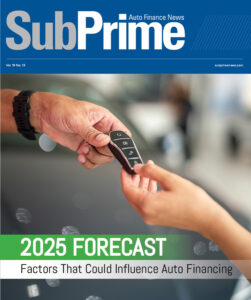Experian Offers Used-Vehicle Market Snapshot
LAS VEGAS — A senior vice president with Experian Automotive recently provided a snapshot into the used-vehicle market, in addition to sharing some year-over-year credit statistics at the National Remarketing and inaugural Pre-Owned Automobile Dealers Alliance meetings last week.
On hand at the event to offer the update was Andy Sheehan, senior vice president of marketing and products.
Vehicles in Operation
According to Experian, 80 percent of vehicles in operation are less than 14 years old. In a breakout of segments, full-sized pickups represented the largest margin at more than 14 percent. Next came standard, mid-range cars and then small economy cars, both over 12 percent market share.
Minivans came in at just over 6 percent, with lower mid-range SUVs falling just below. Interestingly, Sheehan said hybrid vehicles represent about 0.63 percent of current vehicles in operation.
Reviewing market share of vehicles in operation, he also found that General Motors came first at 29.5 percent, with Ford next at 20.6 percent. Chrysler was third at 13.2 percent, while Toyota fourth at 11.2 percent. Other brands represent about 10.3 percent, Honda takes up 7.7 percent, and Nissan is at about 5 percent. Bringing up the rear in the statistics provided was Hyundai at 2.5 percent.
Vehicle Registrations
Looking specifically at new-vehicle registrations, Sheehan said, "Overall, the second quarter of 2009 is down more than 1.2 million units versus the second quarter of 2008. Toyota showed the largest unit drop (down 227,000 units). Chrysler had the largest percent drop (42 percent fewer sales), followed by Toyota (down 41 percent."
Interestingly, he pointed out, "Ford sold more vehicles than Toyota in the second quarter."
As for the used-vehicle market, overall second-quarter sales were down by almost 800,000 when compared to the same quarter of last year.
"GM vehicles showed the largest unit drop (down almost 300,000 units)," Sheehan highlighted. "Used Hyundai sales actually increased (up 1.8 percent)."
Still reviewing the used registrations, he pointed out that just five brands showed an increase in the second quarter over last year. This included, Suzuki, Mercedes-Benz, Land Rover, Hyundai and Porsche.
"Four of the top six performers are luxury brands," he noted. "Used BMW registrations showed a slight decline."
When it came to how long used vehicles are held onto, generally Porsche and Toyota led the way. On the new-vehicle side of this same data, Mercury takes the cake, followed by Buick and Ford.
For new vehicles, Sheehan said, "In 2009, owners of new vehicles have retained them for an average of nearly 70 months (24 months longer than in 2004)."
Meanwhile, from the used-vehicle perspective, he said, "Owners of used vehicles are also retaining them for a longer period: 50.7 months in 2009 versus 36.7 months in 2004."
Experian Automotive also discovered that a greater proportion of new-vehicle owners are tending to switch to used vehicles.
"Of all new-vehicle owners replacing their vehicle in the first six months of 2009, 45 percent purchased a used vehicle. In 2004, the new to used migration occurred 30 percent of the time," he reported.
Continuing on, Sheehan said, "Dodge owners showed the highest migration rate to used vehicles (55 percent). Chrysler had the greatest change, moving from 24 percent to 46 percent (2009 versus 2004). Hyundai showed the least change from 2004 to 2009."
Moreover, he found that luxury brands tended to show the greatest shift in migration to used vehicles. In fact, Jaguar had the highest proportion of new owners moving to used at 39 percent.
"The challenging new-vehicle market, combined with certified pre-owned initiatives are likely the key contributors," he pointed out.
When it comes to used-vehicle loyalty, interestingly, owners of Ford and Chevrolet have the highest loyalty to their brands. On the other hand, Toyota, Honda and Mercedes-Benz owners are much less likely to purchase these brands again.
Auto Finance Market
Next, Sheehan looked at the auto finance market and discovered some more interesting trends.
He offered a breakdown of second-quarter risk distribution on open auto loans:
Super-Prime: 37.1 percent
Prime: 23.8 percent
Non-prime: 15.2 percent
Subprime: 8.8 percent
Deep Subprime: 15 percent
Perhaps due to the economy, deep subprime accounts grew the most at 10.4 percent over the same quarter of last year. Non-prime came next at 6.2 percent, followed by subprime at 5.1 percent. The prime percentage stood at a 2.1-percent upswing. Perhaps due to the economy, super-prime dropped relatively dramatically by 8 percent.
Not surprisingly, credit scores on used financing increased year-over-year, Sheehan said. He also pointed out that consumer credit scores on used vehicles at franchised dealers are rising.
Overall Outlook
Drawing some conclusions at the end of his presentation, Sheehan said, "New- and used-vehicle registrations had a fundamental, sustained drop, but appear to have leveled off. Luxury brands, emerging vehicle segments and Hyundai have been the strongest relative performers in this declining used-vehicle market.
"The 50-percent relative jump in migration from new- to used-vehicle buyers is core to the new-vehicle sales challenge," he continued. "Used buyers are significantly less brand loyal than new buyers."
And finally, he said, "While consumer auto financing is tightening across the board, independent dealers are aggressive and growing share."

 View The Latest Edition
View The Latest Edition

